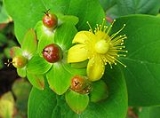
Hypericum androsaemum
Encyclopedia
Hypericum androsaemum, commonly known as tutsan, is a plant in the genus Hypericum
native to open woods and hillsides in Eurasia. It is a perennial shrub reaching up to 1.5 m in height.
s biosynthesis in cell cultures of Hypericum androsaemum involves the presence of a benzophenone synthase
condensing a molecule of benzoyl-CoA
with three malonyl-CoA
yielding to 2,4,6-trihydroxybenzophenone. This intermediate is subsequently converted by a benzophenone 3′-hydroxylase, a cytochrome P450 monooxygenase, leading to the formation of 2,3′,4,6-tetrahydroxybenzophenone.
tutsan was recognised as a pasture weed as early as 1955. Biological control methods were investigated about 60 years ago. In 2008 Landcare Research will begin investigating the feasibility of a biological control.
It is also a declared species in Western Australia
and Victoria
, where it occurs in the wettest regions such as the Otway Ranges and the karri
forests. It does not usually invade improved pastures, but is common in run-down pastures and in native forest
s. When established, tutsan can be dangerous because it is very difficult to remove and is very unpalatable to both native and introduced herbivore
s.
Hypericum
Hypericum is a genus of about 400 species of flowering plants in the family Hypericaceae ....
native to open woods and hillsides in Eurasia. It is a perennial shrub reaching up to 1.5 m in height.
Common name
The common name tutsan appears to be a corruption of toute saine literally meaning all-healthy. This is probably in reference to its healing properties. The leaves are used applied to wounds, and as a stomachich. Nicholas Culpeper, in his 1653 publication Culpeper's Complete Herbal, says "Tutsan purgeth choleric humours ... both to cure sciatica and gout, and to heal burnings by fire." It will also stop bleeding and heal wounds and sores. Apparently it works just as well if it swallowed or used as a salve or ointment. The berries which turn from white/green, to red, to black are poisonous.Chemical composition
XanthonoidXanthonoid
A xanthonoid is a chemical natural phenolic compound formed from the xanthone backbone. Many members of the Clusiaceae contain xanthonoids.Xanthonoid biosynthesis in cell cultures of Hypericum androsaemum involves the presence of a benzophenone synthase condensing a molecule of benzoyl-CoA with...
s biosynthesis in cell cultures of Hypericum androsaemum involves the presence of a benzophenone synthase
Benzophenone synthase
In enzymology, a benzophenone synthase is an enzyme that catalyzes the chemical reactionThus, the two substrates of this enzyme are malonyl-CoA and 3-hydroxybenzoyl-CoA, whereas its 3 products are CoA, 2,3',4,6-tetrahydroxybenzophenone, and CO2....
condensing a molecule of benzoyl-CoA
Benzoyl-CoA
Benzoyl-CoA is a molecule implied in the activity of the different enzymes 4-hydroxybenzoyl-CoA reductase, benzoyl-CoA reductase, benzoyl-CoA 3-monooxygenase, benzoate-CoA ligase, 2alpha-hydroxytaxane 2-O-benzoyltransferase, anthranilate N-benzoyltransferase, biphenyl synthase, glycine...
with three malonyl-CoA
Malonyl-CoA
Malonyl-CoA is a coenzyme A derivative.-Functions:It plays a key role in chain elongation in fatty acid biosynthesis and polyketide biosynthesis....
yielding to 2,4,6-trihydroxybenzophenone. This intermediate is subsequently converted by a benzophenone 3′-hydroxylase, a cytochrome P450 monooxygenase, leading to the formation of 2,3′,4,6-tetrahydroxybenzophenone.
Invasive plant
In New ZealandNew Zealand
New Zealand is an island country in the south-western Pacific Ocean comprising two main landmasses and numerous smaller islands. The country is situated some east of Australia across the Tasman Sea, and roughly south of the Pacific island nations of New Caledonia, Fiji, and Tonga...
tutsan was recognised as a pasture weed as early as 1955. Biological control methods were investigated about 60 years ago. In 2008 Landcare Research will begin investigating the feasibility of a biological control.
It is also a declared species in Western Australia
Western Australia
Western Australia is a state of Australia, occupying the entire western third of the Australian continent. It is bounded by the Indian Ocean to the north and west, the Great Australian Bight and Indian Ocean to the south, the Northern Territory to the north-east and South Australia to the south-east...
and Victoria
Victoria (Australia)
Victoria is the second most populous state in Australia. Geographically the smallest mainland state, Victoria is bordered by New South Wales, South Australia, and Tasmania on Boundary Islet to the north, west and south respectively....
, where it occurs in the wettest regions such as the Otway Ranges and the karri
Karri
Eucalyptus diversicolor, commonly known as the Karri, is a eucalypt which is native to the wetter regions of south west of Western Australia.-Description:...
forests. It does not usually invade improved pastures, but is common in run-down pastures and in native forest
Forest
A forest, also referred to as a wood or the woods, is an area with a high density of trees. As with cities, depending where you are in the world, what is considered a forest may vary significantly in size and have various classification according to how and what of the forest is composed...
s. When established, tutsan can be dangerous because it is very difficult to remove and is very unpalatable to both native and introduced herbivore
Herbivore
Herbivores are organisms that are anatomically and physiologically adapted to eat plant-based foods. Herbivory is a form of consumption in which an organism principally eats autotrophs such as plants, algae and photosynthesizing bacteria. More generally, organisms that feed on autotrophs in...
s.

